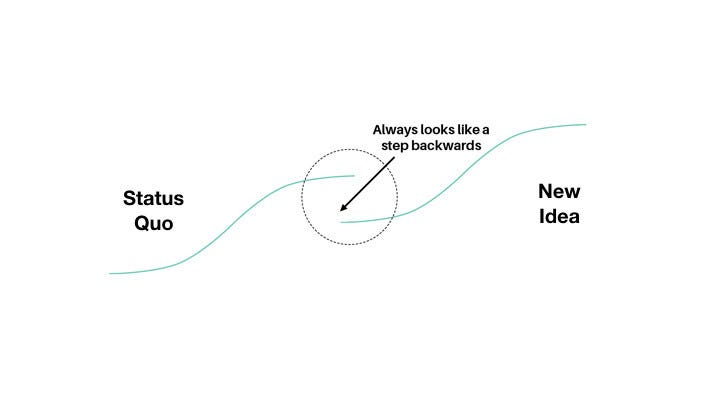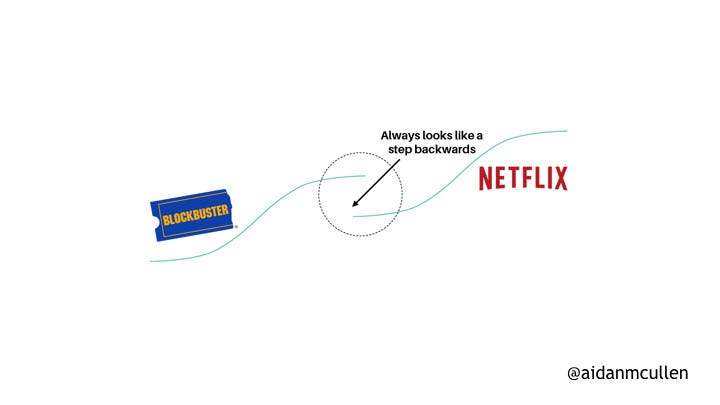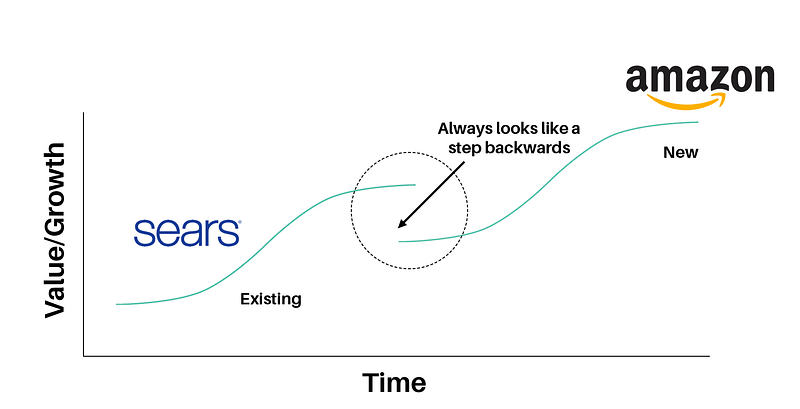
“If I have seen further it is by standing on the shoulders of Giants.” — Isaac Newton
The metaphor of dwarfs standing on the shoulders of giants refers to discovery by building on previous discoveries. While most of us are familiar with the expression as attributed to Isaac Newton, the concept has been traced to the 12th century and attributed to Bernard of Chartres.
While the concept is meant in a positive sense, standing on the shoulders of giants in this age of uncertainty can be a hindrance, not a help.
The way-things-are-done-around-here mindset hampers the anything-is-possible mindset. The corporate stalwarts often drive out the corporate insurgents.
Walking the Line
“The reasonable man adapts himself to the world: the unreasonable one persists in trying to adapt the world to himself. Therefore all progress depends on the unreasonable man.” ― George Bernard Shaw
There is a fine line between being a corporate changemaker and being vilified as a corporate troublemaker.
Most innovation workers work in a permanent state of fight or flight. They are the challengers of the status quo and the status quo does not like to be challenged. They are the corporate insurgents and the organisation crushes internal threats with more vengeance than external threats. The insurgents are the credit makers, the organisations are the credit takers.
Corporate insurgents work under various corporate job titles: heads of innovation, heads of digital, entrepreneurs in residence, intrapreneurs, heads of learning and development, heads of transformation and sometimes CEOs.
Unfortunately, most of these brave individuals eventually leave the organisations they so want(ed) to transform. Sometimes they underestimated the enormity of the task. Other times they were “sold a pup”, where the organisation thought it was ready for change, but it was far from it. In the worst cases, they were hired as “lipstick on a pig”, their appointment was the innovation strategy.
In so many cases, innovators are rejected like a bad tissue transplant.
This Thursday Thought puts those failed skin grafts under the microscope.
Failed Skin Grafts
British biologist, Sir Peter Medawar (1915–1987) is regarded as the “father of transplantation”. He earned this moniker for his work on graft rejection and the discovery of acquired immune tolerance, which was fundamental to the practice of tissue and organ transplants.
Medawar once said “The human mind treats a new idea the way the body treats a strange protein, it rejects it.” This observation sums up why we see so much attrition amongst corporate changemakers. The corporation rejects new ideas and the people who propose them.
On this week’s Innovation Show, we speak to Gib Bulloch, the author of ‘The Intrapreneur’. Gib is a pioneer of corporate insurgence and the founder of the tremendously successful “Accenture Development Partnerships” or ADP.
Gib shares his story of how he battled sustained resistance within Accenture, despite certain leadership support to grow the ADP from a vision to a major differentiator for Accenture.
Throughout his excellent story he refers to the resistance he encountered as the corporate immune system: a molotov cocktail of culture, risk management and inertia.
The Corporate Immune Systems
Did you ever wonder how the flu can make our whole body ache from our joints, to our muscles and even our skin? It is not simply the flu virus which causes the symptoms, it is our brains, but why do our brains do this?
Pain is a warning signal produced by the brain. The brain uses pain to make us aware of sensations or situations that may be a threat to our health. When we are sick, our bodies spend precious energy on fighting infection and virus. Symptoms such as debilitating pain are our brain’s way to slow us down so we maintain all our energy for fighting infection. Resisting rest is futile and we eventually have to succumb to the directives of our brains and allow our immune systems cure our illness.
Many organisations get to a stage of maturity where processes are in place, profit lines are established and compensation is based on execution of the business as it is today. Any corporate energy expended beyond this is deemed a waste of resources.
When organisations encounter pain (perceived or real) such as external disruption or threats from new market entrants, they react in the same way as the brain does to the flu. They shut down anything that is not core to survival.
Just as the brain creates perceived pain when we have the flu, an organisation accentuates pain points (imagined and perceived) when it is under stress. These pain points manifest as ungrounded objections to change, “that will never work”, “we tried that before”, “that is beyond our area of expertise”.
The corporate immune system kicks into full effect and stifles innovation.
“Big ideas are little ideas that no-one killed too soon. “ — Seth Godin
Oversized Shoulders
In cognitive psychology and decision theory, loss aversion refers to our tendency to prefer avoiding losses to acquiring gains. In simple terms it seems better to us not to lose €5 than to find €5.
The loss hurts us more than the possible gain.
This tendency has an immense impact on the corporate insurgent. The insurgent is proposing an idea that seems like a threat to the business as it is today, despite being a possible gain.
All the incumbent hears is: “distraction”, “threat”, “possible loss”. Couple this with the fact that the next curve will always start small and thus will always appear to be a step backwards.
Oh, and:
And:
Snake and Ladder Leadership
In his story of intrapreneurship (in the early noughties), Gib Bulloch tells us his journey of setting up a new unit within a corporate behemoth was like playing snakes and ladders. Periods of inspiring momentum were met with agonising bouts of adversity.
The role of leadership makes a huge difference to the changemaker. Some leaders are lawnmower leaders and clear the path for the intrapreneur, while others are solely focused on growth or EBIDTA and anything that deviates from that is demoted to the waste basket.
Snake and ladder leadership is one of the reasons we see high attrition rates with changemakers. In large organisations leadership can be transient, often a supportive leadership team changes and so do the organisational objectives. The intrapreneur who had the blessing to futureproof the company suddenly finds themselves isolated without budget and without blessing. They hit a “snake” and have to win over a new leadership team. As Gib Bulloch puts it, they find themselves without necessary “air cover”.
Death by a Thousand Cuts
“For he who innovates will have for his enemies all those who are well off under the existing order of things, and only lukewarm supporters in those who might be better off under the new.” ― Niccolò Machiavelli
The intrapreneur will experience setback after setback, cancelled out by encouraging wins. However, it is the accumulation of the setbacks that eventually drives the intrapreneur out of any organisation.
The corporate insurgent encounters a form of emotional bullying by her peers. She will be excluded from meetings, find the credit for her ideas taken by others and encounter resistance from many departments, compliance, legal and sales. She will find herself lacking psychological safety.
However, most resistance will come from those who most benefit from the status quo.
For the changemaker to succeed, we need Leadership support from the top and movement from the middle. When there is a consistent echo seeking change, then change will happen.
We need sustained momentum. We need paradigm shift from business with the goal of shareholder value to a goal of shared value.
I leave you this week with an inspiring quote by the excellent Margaret Wheatley:
“In spite of current ads and slogans, the world doesn’t change one person at a time. It changes as networks of relationships form among people who discover they share a common cause and vision of what’s possible. This is good news for those of us intent on changing the world and creating a positive future . Rather than worry about critical mass, our work is to foster critical connections. We don’t need to convince large numbers of people to change; instead, we need to connect with kindred spirits. Through these relationships, we will develop the new knowledge, practices, courage, and commitment that lead to broad-based change. “
IF YOU LIKE THIS POST PLEASE THUMB IT AND SHARE IT, YOU MIGHT ALSO LIKE THE POSTS BELOW AND EPISODE 106 OF THE INNOVATION SHOW WITH GIB BULLOCH, LINKS BELOW.
Tips for Corporate Innovators, Intrapreneurs and Changemakers: Change needs lightening rods
EP 106 The Intrapreneur: Confessions of a Corporate Insurgent Gib Bulloch
Gib Bulloch is an award-winning social intrapreneur who consults, writes and speaks on topics relating to the role of business in society. The proceeds of his book “The Intrapreneur: Confessions of a Corporate Insurgent” go towards social business associations.
Gib believes passionately in the power of business to change the world and in the power of the individual to change the world of business. Gib founded and scaled Accenture’s global “not-for-loss” consulting business, ADP.
He left Accenture in 2016 to explore new ways of supporting purpose-driven insurgencies within the corporate world.
We discuss:
The Challenge of Status Quo
Driving change from within organisations
Corporate Stress Corporate
Mental Bullying/Emotional Pressure
Social Change
Have a listen
Soundcloud https://lnkd.in/gBbTTuF
Spotify http://spoti.fi/2rXnAF4
iTunes https://apple.co/2gFvFbO
Tunein http://bit.ly/2rRwDad
iHeart Radio http://bit.ly/2E4fhflYou can find out more about Gib here:
#Gib Bulloch #Intrapreneur #Corporate Insurgent #Accenture #Circle of Young Intrapreneurs #Circleofyi #Changemakers #Transformation #DigitalTransformation #AccentureDevelopmentPartnerships #ADP


